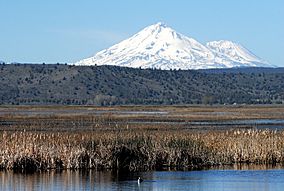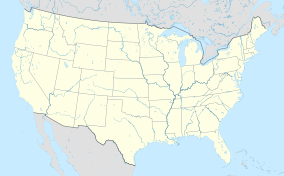Lower Klamath National Wildlife Refuge facts for kids
Quick facts for kids Lower Klamath National Wildlife Refuge |
|
|---|---|
|
IUCN Category IV (Habitat/Species Management Area)
|
|

Marsh Scene at Lower Klamath NWR
|
|
| Location | Siskiyou County, California / Klamath County, Oregon, United States |
| Nearest city | Klamath Falls, OR |
| Area | 50,913 acres (206.04 km2) |
| Established | 1908 |
| Governing body | United States Fish and Wildlife Service |
| Website | Lower Klamath NWR |
| Reference #: | 66000238 |
| Designated: | January 12, 1965 |
The Lower Klamath National Wildlife Refuge is a very important place for animals and plants. It's located in the Klamath Basin near Klamath Falls, Oregon. This refuge was the very first place in the United States created specifically to protect waterfowl, like ducks and geese.
It was set up by President Theodore Roosevelt way back in 1908. This special area covers over 50,912 acres (about 206 square kilometers). Most of it, about 44,294 acres, is in California. The rest, about 6,618 acres, is in Oregon.
The refuge has many different types of habitats. You can find shallow freshwater marshes, open water, and grassy uplands here. There are also croplands that are carefully managed. All these different areas provide homes and food for many kinds of waterfowl and other animals.
Contents
Why the Refuge Was Created
The Lower Klamath National Wildlife Refuge was created for a very important reason. In the late 1800s, too many migratory birds were being hunted. People realized that these birds needed protection. So, the idea of creating a safe place for them, a wildlife refuge, became very important.
Goals of the Refuge
The main goals of the refuge are to protect the homes of plants and animals. This includes many migratory birds that travel long distances. The refuge also works to keep the wide variety of life, called biodiversity, safe in the Klamath Basin.
The refuge also tries to combine wetland areas with farming in a way that helps nature. They use smart farming methods to control pests without harming the environment.
Fun Things to Do at the Refuge
The Lower Klamath National Wildlife Refuge offers many activities for visitors. You can learn about nature through educational programs. It's also a great place for photography and watching wildlife. Sometimes, hunting is allowed in certain areas to help manage animal populations.
Amazing Animals and Plants
The refuge is home to many different kinds of birds. Some of the amazing birds you might see here include:
- Bald eagle: A majestic bird, the national symbol of the U.S.
- Golden eagle: Another large and powerful bird of prey.
- American white pelican: A large white bird with a huge pouch under its beak.
- White-faced ibis: A wading bird with a long, curved beak.
- Snow goose: A beautiful white goose that migrates in large flocks.
- Ross's goose: A smaller white goose, similar to the snow goose.
- Greater white-fronted goose: A goose with a white patch at the base of its bill.
- Canada goose: A common goose with a black neck and white chin strap.
- Peregrine falcon: One of the fastest birds in the world.
- Northern pintail: A duck known for its long tail feathers.
- Mallard: A very common and well-known duck.
- Gadwall: A dabbling duck often found in marshes.
- Canvasback: A diving duck with a distinctive sloped head.
- Western grebe: A water bird known for its elegant courtship dances.
- Eared grebe: A small grebe with golden ear tufts.
- Black tern: A small, graceful tern that flies over water.
- Tricolored blackbird: A blackbird with a bright red and white patch on its wing.
Protecting the Refuge
Taking care of the refuge involves many important activities. This includes managing the water systems to make sure there's enough water for the wetlands. They also watch how farming activities affect the natural habitats.
The refuge faces challenges like the loss of wetland areas. They also work to improve water quality and deal with periods of drought. All these efforts help keep the Lower Klamath National Wildlife Refuge a safe and thriving home for wildlife.
Gallery
-
Ross's geese on a freshwater marsh
-
Marsh with American coots






